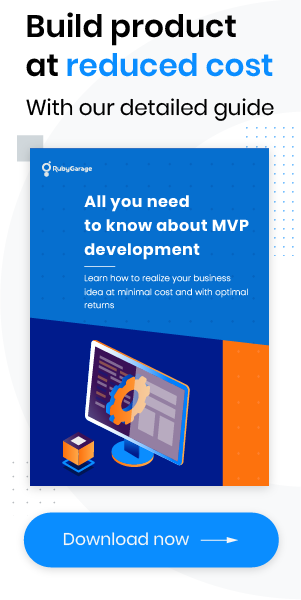-
Product Management
Software Testing
Technology Consulting
-
Multi-Vendor Marketplace
Online StoreCreate an online store with unique design and features at minimal cost using our MarketAge solutionCustom MarketplaceGet a unique, scalable, and cost-effective online marketplace with minimum time to marketTelemedicine SoftwareGet a cost-efficient, HIPAA-compliant telemedicine solution tailored to your facility's requirementsChat AppGet a customizable chat solution to connect users across multiple apps and platformsCustom Booking SystemImprove your business operations and expand to new markets with our appointment booking solutionVideo ConferencingAdjust our video conferencing solution for your business needsFor EnterpriseScale, automate, and improve business processes in your enterprise with our custom software solutionsFor StartupsTurn your startup ideas into viable, value-driven, and commercially successful software solutions -
-
- Case Studies
- Blog
How to Get Investors for Your Business with Only an MVP
Every day we observe the emergence of new startups. Many of these startups have brilliant ideas to share with the world, though they often don’t get a chance to reach their audiences due to lack of funding.
Surely, you don’t want to follow the destiny of failed startups; nobody does. Therefore, if you’d like to find an investor for your business, consider our tips below that’ll help you appeal to an investor and get funded.
1. Validate Your Business Idea with an MVP
An MVP, or a minimum viable product, is a concept that leaped from the pages of Eric Ries’ book Lean Startup. Lean Startup shifted the whole startup industry by introducing a new, scientific approach to building products and services.
According to Ries, startups are working in conditions of high uncertainty, and thus they can’t plan everything ahead. To deal with uncertainty, startups should stick to a “Build-Measure-Learn” cycle that involves rapid building of minimum viable product, testing that product with the target audience, and making conclusions based on that research.
The simple “Build-Measure-Learn” method has been adopted by many successful startups including Mint, a financial management software company. This is how Mint’s founder, Aaron Patzer, describes his experience building the startup:
When I started Mint I took a very different approach...and this is sort of the methodology that I formed (Validate your idea > Create a prototype > Build the right team > Raise funding). Number one is to validate your idea. I actually didn’t write a line of code until I did about three or four months’ worth of thinking on Mint, which I think is counter to what a lot of people will suggest...The next thing was to create a prototype, then to build the right team, and then to raise funding.
Mint’s success proves that investors are more likely to accept a startup idea if it’s backed by not only a business plan but by empirical data as well.
To validate your startup idea efficiently, elicit user feedback to find out what your customers really want, not what you assume they want. Even if your users react negatively to a product, that’s a great chance to improve at the early stage and build a product around your users’ needs.
If you feel that your startup idea isn’t viable, it makes sense to shift your whole concept. Micah Rosenbloom, a venture partner at Founder Collective, points out that you should analyze the prerequisites of that shift so you know exactly what should be changed in your product: whether it’s a single feature or a complete revamping.
2. Create a Business Plan
Whether you get funded by a bank or an investor, either will require a business plan. A business plan defines key information about your business (for example, what products or services you offer and what markets you’re targeting), goals you want to achieve, and how you’ll achieve those goals (a marketing strategy and a plan of operations). Despite the fact that some startup owners find writing a business plan boring or unnecessary, there are a few reasons why you should create a business plan:
- To structure your business idea and find out what you need to achieve your goals.
- To determine your strengths and weaknesses and evaluate risks and constraints that may keep you from success.
- To keep up with the progress of project implementation; a business plan gives a clear vision of a project’s milestones, funding for a business, and so on.
- To set requirements for team members, hire people with necessary expertise, and roughly estimate payroll.
- To pitch your idea to potential investors or bank representatives by relying on a well-structured document.
Let’s take a look at parts you should include in your business plan.
1. SWOT Analysis
A SWOT analysis detects Strengths, Weaknesses, Opportunities, and Threats to your business. Conducting a SWOT analysis helps you better build your marketing and business strategy.
As a rule, a SWOT analysis is drawn as a matrix divided into four sections. To fill in each of these sections with complete and relevant answers, ask yourself a series of questions that will stimulate your thinking. Even though these questions will be different for each kind of business, there are common questions that people ask themselves during SWOT analyses.

2. Competitor Analysis
A competitor analysis is done as part of a SWOT analysis or at the initial stage of your business planning. The information gathered as the result of a competitor analysis is used to determine your marketing strategy.
Here’s how you can perform a competitor analysis:
- Determine your direct competitors ‒ businesses that offer the same product or service that you do – and indirect competitors. Indirect competitors can be foreign companies, companies that offer related products and services, and businesses that may compete with you under certain conditions (economic, political, climate changes, shifting trends, etc).
- Create a competitor product summary. Analyze the products of your competitors from the standpoint of value propositions, features, strengths, and weaknesses. Key points to consider are product and service offerings, pricing, and sales channels.
- Analyze marketing profiles. A marketing profile includes analysis of a competitor’s target market, market share, and marketing strategies. Often, analysis of a marketing profile includes study of SEO structure, social media, and content (blog posts, videos, whitepapers, case studies, etc).
3. Analyze the Market for Your Business
Get insights on the market you’re going to enter. Consider the industry you’re going to work in. Provide information like size of the industry, trends and growth patterns, and anticipated customer demands.
Pick a target market and research its potential and growth; don’t try to embrace as many markets as you can. Next, determine your customers (for example, in terms of demographics) and demonstrate how your product satisfies the needs of your target customers.
Finally, include information on pricing, gross margins, and promotions (such as discounts or sales) that you’re planning to offer. Provide an overview of how your pricing structure will give you a competitive advantage.
4. Map Out a Marketing Strategy
A marketing strategy, or a marketing plan, determines how you’ll enter the target market (for example, by driving out your competitors), how you’ll spread the word about your products and services (on Twitter, Facebook, and Product Hunt, for instance), and what tools you’ll use for those purposes.
5. Create an Operating Plan
In your operating plan, you need to describe how you’ll prepare your product or service for sale. Operating plans are different for each kind of business, however there are general points to include in any operation section, such as workforce (number of workers needed, expertise, levels of engagement, details of employee contracts, and more), facilities (all your assets including buildings and inventory), equipment, and processes (steps for making your products or providing your services).
6. Create a Financial Plan
Whether you’ll get business funding from venture capitalists, business angels, or banks, your financial backers will be interested in seeing your financial plan. A financial plan includes three major topics:
- a sales forecast
- a cash flow projection
- a balance sheet
In a sales forecast you show your revenues, costs, and profits for a specific period (for example, on a quarterly or a monthly basis). As a rule, businesspeople provide detailed information on each point. For example, the costs part may include data on wages, rentals, materials, etc. On the internet, you can find plenty of ready-made sales forecast templates that you can tailor to your needs.
Show how you expect your cash to be spent or gained in a cash flow projection. As a rule, businesspeople take into account previous data like profits and losses over the past years to make assumptions about cash flow. However, if such data isn’t available, you may take advantage of cash flow management software such as QuickBooks and Float that calculate and forecast your cash flow easily.
Finally, in a balance sheet you present three values: assets (the financial worth of objects you possess), liabilities (your debts), and equity (assets minus liabilities).

3. Get a Great Team
While MVP is a common buzzword in the startup world, the term MVT ‒ minimum viable team ‒ isn’t as known. Above, we talked about a business plan and a minimum viable product as factors that influence an investor’s decision to fund your business.
A great team plays an important role in an investor’s decision making as well. By a great team, we mean a cohesive team of professionals ‒ a team that makes a good impression and wins an investor’s favor.
Cohesiveness is a key factor that differentiates a startup team from an established business team. According to Lindred Greer, who has been studying the behavior of startup teams, members of such teams are practically “married” to each other; they’re loyal and enthusiastic about working towards a common goal.
To make sure you hire the right people for your team, you can ask yourself a few questions such as:
- Does this candidate share my vision of the product?
- Do our values, such as honesty and reliability, align?
- Does this person possess the personal traits I’m seeking in people?
- Is this person flexible enough to be able to adapt to sudden changes, as always happens with startups?
- Does this person demonstrate enough commitment for the job? Is there a chance that this candidate will leave as soon as there’s a more attractive vacancy?
Remember that personality is an essential factor to consider when putting a startup team together; while professional skills can be improved or learned, people’s attitudes and mindsets can hardly be changed.
3. How to Get Investors For Your Startup
Once you’ve built an MVP, written a business plan, and put a team together, you’re ready to start looking for investors who’ll help you provide longevity for your startup. Reaching the right investor who will complement your team, mentor you, and give you valuable advice is as important as polishing your pitch deck.
A common mistake of many startups is pitching to all investors in the area without considering important factors like types of businesses the investors prefer. Richard Harroch, an entrepreneur and investor, points out that it’s important to do your homework before pitching to an investor.
Research about investors should include points like industries they specializing in, their background (companies they’ve invested in), how much money they usually invest, locales they invest in, connections, and hobbies. By doing this research, you’ll be able to find your Mr. Right ‒ an investor you’ll share much more with than just a money loan.
After you’ve narrowed down the list of investors you’re going to pitch, consider how you’ll reach out to them.
Where to Find Business Investors
- Online platforms. Online platforms gather startups and investors under one roof. The benefit of such platforms is that you deal with minimal documents. Generally, you’re only required to create an attractive project profile and submit it to a website administrator. In case a startup wins an investor’s favor, a deal is closed offline. As a rule, platforms charge 5–10% for each deal. Examples of online platforms for investor matchmaking include AngelList, F6s, 500 Startups, and Gust.
- Lists of investors. Lists of investors can be found on websites like Forbes, BusinessInsider, CrunchBase, and AngelList. As a rule, these lists contain important information such as investors’ backgrounds, the cities they’re based in, recent investments, and social media accounts. Using that data, you can tailor your pitch strategy specifically for the person you’re going to contact.
- Conferences and meetups. Investors often join communities in which they share their experiences and investment best practices. Richard Harroch mentions that investors often rely on personal connections to get a piece of advice on whether to make an investment. Therefore, attending specialized events like conferences and meetups is a must. During these events, you can get acquainted with an investor (or a person who can introduce you to the person) in a relaxed atmosphere, do great networking, and exchange contacts. Consider attending annual events that gather angel investors, venture capitalists, and startups from all over the world like AngelSummit.io, Webit Festival Europe, and SVOD.
4. How to Better Appeal to Investors
Investors are above all ordinary people who make their decisions based on insights and emotions. Thus, it’s important to demonstrate your credibility from the very first contact, whether it’s a PowerPoint presentation or a meeting in real life. To better appeal to investors, follow the tips below:
- Don’t just send a business plan. One the most frustrating pitches you can make is sending your 50-page business plan and hoping to be picked by an investor. Seasoned investors recommend including a summary of your business and a short presentation with 10–15 slides. Tim Berry, an American entrepreneur, highlights that you should make your business plan structured and bold by including elements like bullet points, lists, and tables.
- Show your teamwork. It’s not a secret that the team is what investors pay attention to upfront. Investors want to make sure that you’re professionals and great team workers, so don’t forget to highlight your teammates’ skills, experiences, motivations, and involvement in the business. Also, during a face-to-face pitch, investors prefer the whole team to speak rather just a CEO.
- Include a money forecast. Some startups don’t include a credible sales forecast or simply ignore that part of their business plans. Barry Kumarappan, a director at Secerno Real Estate, advises that you “live” the figures you include into your business plan so you can predict risks and financial dynamics.
- Leverage the power of networking. Getting in touch with an investor is much easier with a referrer ‒ a person who can introduce you. Look through your existing network of relatives, classmates, coworkers, and everyone else you’ve ever dealt with ‒ quite often you’re much closer to an investor than you imagine! Also, improve your social media presence: create consistent, professional-looking profiles that represent your business and expertise. Websites like LinkedIn, Twitter, Facebook, and Google+ allow for quality networking and sharing of content that reinforces your online presence.
- Make an efficient pitch. An efficient pitch should be personalized. Consider the information you gained during investor research when writing your pitch deck. Address investors by a name, and include a small note that explains why you’re writing to them and a short story about your startup. Tim Berry says the following: “Tell us a good story we can believe in. Don’t tell us your business is a game changer ‒ we’d rather absorb your story and decide that for ourselves.”
Now that you have some tactics to reach out to investors and make a successful pitch, prepare for getting turned down or simply ignored ‒ something that practically all startups are going through. Use simple follow-up techniques to stay in touch with investors; for example, share notable news and achievements of your startup. An unobtrusive, professional follow-up is always appreciated.
If you’d like to get even more exciting posts on MVP insights and how to find investors for a business, follow us on Twitter and Facebook!









